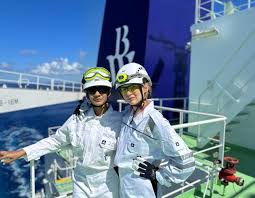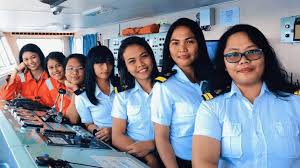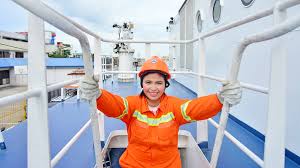Philippine Leads
Since decades the seafarers of Philippines have remained the biggest provider of ocean based workers out of the world’s estimated total 2 million seafarer workforce. During the period from 2016 to 2021 the Philippines deployed over 400,000 Filipino seafarers reflective of the country’s strong maritime strength, seafaring traditions and heritage. No doubt Philippines is a maritime nation .It is estimated that there is one Filipino seafarer for every four crew members on board a vessel at any given time across the oceans.
 Source;BW-LPG
Source;BW-LPG
Seafarers & GDP
At the summit “ Future of Shipping : Seafarer 2050 “ topics included economic contribution of seafarers to a country’s GDP, creation of employment opportunities for the youth , logistic and maritime clusters, seafarers labor conditions and accreditation of seafarer training institutes. Mariners comprise around 1.8% of UK employment , constitute 1.9% of UK GDP and contribute 1.6% of UK state revenues. In the United States of America the maritime sector contributed US $ 432 billion to the national economy or around 2% of its GDP , just in the year 2022.
The Philippines , comprising 14% of the global seafarer workforce, being cognisant of the significance of its seafarers in the country’s GDP has initiated sustainable measures and proactive actions for the purpose of securing its maritime future. The Philippines civilian and merchant navy maritime authorities remain actively engaged with the Maritime Just Transition Task Force and the International Advisory Committee on Global Maritime Affairs. In the Pacific region Indonesia’s initiative to collaborate with skills councils on maritime education are appreciable and they have managed to penetrate Pakistan’s domestic and port marine services to the detriment of local mariners.
 Credit;Maritime Executive
Credit;Maritime Executive
Remittances & Seafarers
The Bangko Sentral ng Pilipinas (Philippines Central Bank) shared that in the year 2022 seafarer remittances constituted almost 22% of all USD remittances from Filipino workers overseas . For the year 2022 Bangko Sentral ng Pilipinas announced a record-breaking $ 34 billion in remittance accounting for 8.9% of the country’s GDP. The Central Bank reported that remittances sent inwards by Philippine seafarers were of an amount of $ 6.71 billion in the year 2023. Data from the Bangko Sentral ng Pilipinas (BSP) emphasises the economic contribution of sea-based Filipino workers with their remittances averaging USD $ 602 million (roughly PHP40 billion) monthly .
 Credit ; IMO
Credit ; IMO
Legal Protection
The Republic Act No. 12021 or An Act Providing for the Magna Carta of Filipino Seafarers is the law which prescribes the rights and duties of Filipino sailors, qualifications, terms of employment, education and training requirements. The salient features of this statute entail seafarers’ rights and duties, women in the maritime industry, emergency rescue of domestic seafarers, manning levels and crew competency requirements, terms and conditions of employment, accommodation and food, medical care, inspection and enforcement and green lane for overseas and domestic mariners. The legislation insists on fulfilment of requirements for Philippine-registered ships shipboard training, incentives and awards granted to the maritime industry, repatriation, reintegration, education and training and dispute resolution. Such statutory protection is a solace for mariners and their families.
Women Entering Maritime
Today women represent only 1.2% percent of the global seafarer workforce as per the BIMCO/ICS 2021 Seafarer Workforce Report indicative of global trends in gender balance.The BIMCO report reveals that around 24,000 women are presently working as seafarers, a significant 45 % increase as compared with the 2015 BIMCO report. Seafaring has traditionally been a male dominated industry and the International Maritime Organisation (IMO) has initiated moves and introduced measures to support women to achieve a representation in conformity with modern day gender balance. Relying on its framework of maritime development and through its Women in Maritime programme, under the slogan: “Training-Visibility-Recognition”, the IMO has adopted a strategic approach towards enhancing the contribution of women as significant maritime stakeholders. The IMO endorses the participation of women in shore-based as well as operational and sea-going roles.
SDG’s & Blue Economy
IMO is strongly committed towards assisting Member States in achieving the UN 2030 Agenda for Sustainable Development and the 17 Sustainable Development Goals (SDGs), particularly Goal 5 “Achieve gender equality and empower all women and girls”.
 Credit;ITF-Seafarers
Credit;ITF-Seafarers
Women constitute only 19 % of the total maritime workforce and sadly only 1 % of them are deployed offshore and on ships. The National Maritime Polytechnic , Manila shared that out of 64 surveyed shipping companies only 28 compamies had established formal policies on gender equality which is a far cry from becoming an inclusive and equitable maritime industry. Philipino women remained under represented in shipboard roles with participation restricted to hospitality , steward or catering sub sectors at 402 out of 953 Filipino women seafarers. It was revealed by the National Maritime Polytechnic from amongst the 953 women seafarers only 100 women were operationally deployed within crewing and shipping companies at executive or management positions. Pakistan has not been able to induct women in the blue economy domain and merchant navy and to date there is only one woman nautical graduate , and that too from a private nautical training institute at Karachi. The BIMCO Report of 2021 predicts that in view of the expected demand for STCW certified officers there will be a need for an additional 89,000 officers by the year 2026 to operate the worlds merchant fleet. The Karachi Port Trust (KPT) has the unique distinction of being the only port in the world to deploy women in active and operational security roles. Pakistan is a maritime nation with a coastline spanning almost 1o46 kilometers . Beyond the coast the Exclusive Economic Zone (EEZ) including recently added continental shelf , extends 350 NM and has a total area of 290,000 Sq km. The visibility and presence of women in the private sector shipping , national flag carrier, port and logistic domain is minimal. The coastal province of Balochistan has pristine beaches and lagoons and its fishing stocks have not been depleted yet its human resource potential in the modern day fishery and maritime sector is minimal . A private sector international maritime university and nautical training institute may be established along Balochistan scenic coast by any private sector consortium instead of churning out graduates in the traditional fields who desperately venture abroad and pursue jobs at lower executive and management positions , especially in the Gulf region. Almost three decades back pilgrims would regularly go to perform Hajj on ships. Since its discontinuance sea tourism or religious tourism has finished expect in non commercial circumstances. It is time for Pakistan’s financial and commercial sector to enter the global seafarer market in a big way which would in the first instance boost remittances, lower cost of transportation and cost of doing business at the same time , make exports competitive, create business and employment opportunities for the youth especially women, enhance international impact, comply with international obligations and treaties and SDG’s and ensure food and energy security and enhance GDP. The blue economy potential of Pakistan can yield billions in USD terms in many areas including offshore hydrocarbon exploration, container shipping, sub sea internet cables and internet hubs, transshipment hubs, food silos , bunkering , oil storage, green fuels , port digitisation, nautical artificial intelligence (AI), Karachi’s and Gwadar estate and coastal lagoon development , cyber security training against spoofing, capacity building of seafarers, tourism and cruise hospitality, shipbuilding and ship repair, inland waterways , fishing and logistic hubs connecting the Far East and Central Asian states. The national flag carrier (PNSC) has around a dozen vessels whereas many maritime countries in the region have more then one thousand ships registered under own country flag. Merchant ships enhance floating storage thereby reducing dependency on foreign carriers and nowadays even land locked states maintain shipping lines. The Geneva based private ship owned company, Mediterranean Shipping Company (MSC) average annual earning are in the range of US $ 24 billion. After 1971 PNSC had a fleet of 56 ships. The United Nations Conference on Trade and Development (UNCTAD) 1964, stipulates that ships registered in Pakistan can carry 40 % of national cargo, the purpose being to improve trade of developing countries as many shipping lines were owned by developed countries. Pakistan’s annual trade in the year 2001 , when Merchant Marine Policy was promulgated , was 39 million tons and the freight bill estimated at US $ 1.5 billion while the share of the national carrier was limited to merely 2 million tons (5 %) representing an ongoing depletion of foreign exchange resources . In the year ending June 2022 total annual trade was around 110 million tons and freight charges almost US $ 8.0 billion
The draft strategic framework proposal for realising the Blue Economy potential is at the final stage.
Author ; Nadir Mumtaz
Trademark Blue Economy IPO-PK

Blue Economy (Services) (Pvt.) Limited
website ; blueeconomynews.com
Credit/Source
https://web.senate.gov.ph/photo_release/2023/0926_00.asp
https://www.pna.gov.ph/articles/1240480
ics-shipping.org/representing-shipping/
https://www.pna.gov.ph/articles/1250562
https://www.congress.gov.ph/media/press-releases/view/?content=9078&title=Magna+Carta+of+Filipino+Seafarers+ensures+protection%2C+continuous+employment+for+Filipino+sailors+-+Speaker+Romualdez
https://safety4sea.com/seafarer-remittances-account-for-8-9-of-philippines-gdp/
https://www.pc.gov.pk/uploads/pub/Pakistan_Coastal_Development_ICZM.pdf

Leave A Comment